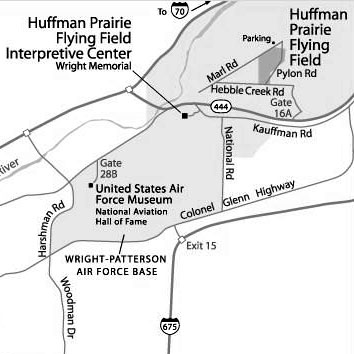 It was a cold March morning, and the wind chill was in the 20s, when I decided to visit one of the newest National Parks, in Dayton, OH. I've been to the Air Force Museum more times than one can count, but I've never taken the extra five minutes to drive to the Huffman Prairie Flying Field and the nearby visitor center. On this March morning, I had decided it was time.
It was a cold March morning, and the wind chill was in the 20s, when I decided to visit one of the newest National Parks, in Dayton, OH. I've been to the Air Force Museum more times than one can count, but I've never taken the extra five minutes to drive to the Huffman Prairie Flying Field and the nearby visitor center. On this March morning, I had decided it was time.
The Huffman Prairie Flying Field is five minutes from the Air Force Museum, nestled in a corner of the Wright-Patterson Air Force Base. Approximately 84 acres are preserved where the Wright Brothers perfected their flying machine. The field was on the farm of one Torrance Huffman, next to the Simms Station electric trolley stop. The prairie was where young Orville had gone along with classmates to sketch the flora of this unique piece of ground. The brothers, wanting to prove that the flying machine could be more than just a toy, wanted a place fairly close to home, but far enough away from the prying eyes of the public, to perfect their invention. This prairie served that purpose in 1904-1905.
Being around 8 am on a weekday, I was the only person at the prairie during my visit. I wasn't sure where to park, so I pulled over to the side of the road. Everything was quiet, except for the traffic one could hear coming from the local highway. Even the base seemed sleepy. No aircraft flew overhead the hour I spent walking the prairie. Only the numerous robins, who didn't mind any human intrusion, were there for companions. The groundhogs, with their numerous holes in the rich, black soil, decided to stay in on this winter morning.
I was quite pleasantly surprised to see the amount of interpretation going on at Huffman Prairie. There are more than a dozen descriptive signs that give the visitor the full story of the flying that took place at the prairie, along with a replica hanger and catapult. The hanger has some exhibits within, but the doors weren't open during my visit. One sign described the flight of Milton Wright, the brothers' 81-year-old father, who, during the course of his first ever sojourn into the air, leaned over and told his son "Higher, Orville, higher!" They climbed to 395 feet. One interesting feature is the outline in stone of the flying school (formed in 1910) the brothers had started at the prairie, where such a notable as "Hap" Jordan learned to fly.
The interpretive center is about two miles away, and is typical of the smaller national parks. The center sits on a bluff overlooking the base, and one can see the prairie from this location. There is a memorial to the brothers there, along with a handful of small Indian mounds in the corner of the park. The center itself has displays about the brothers, as well as information on the advances that took place at the base. The gift shop is well stocked with related books, many more on the Wrights than one can find at the Air Force Museum.
Getting to the prairie and the interpretive center is simple. Pulling out of the Air Force Museum, take a right, and follow the signs. The interpretive center will be on the right, while the entrance to the prairie is at Gate 16B. The signs on the base will get you to where you want to go. There is a parking lot on the north side of the field (in the woodline near the old station location), but I didn't see it until after I had walked most of the ground. Both the prairie and the center are easy on the legs, but do watch for those groundhog holes!
The Huffman Prairie Flying Field and Interpretive Center are units of the Dayton Aviation Heritage park. The other units are on the west side of Dayton, which will be another trip. Make it a point, the next time you are going to the Air Force Museum, to take an additional hour and visit the Huffman Prairie. I know I won't overlook this part of our National parks again.
Back to The Herald 58 Table of Contents
Back to The Herald List of Issues
Back to MagWeb Master Magazine List
© Copyright 2004 by HMGS-GL.
This article appears in MagWeb.com (Magazine Web) on the Internet World Wide Web. Other articles from military history and related magazines are available at http://www.magweb.com